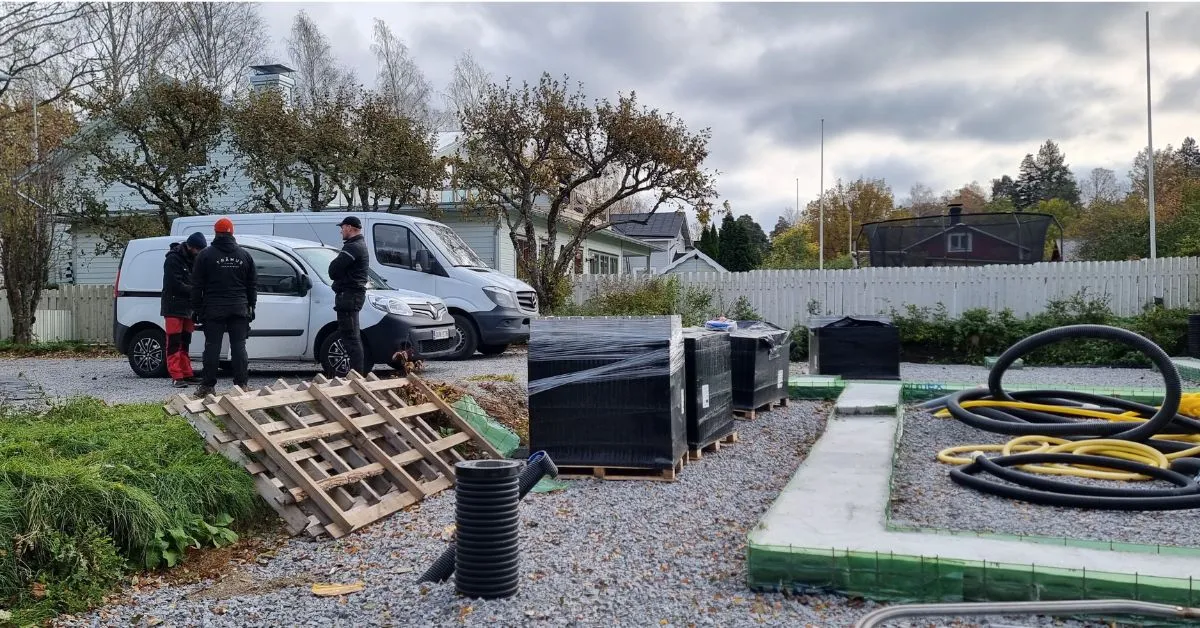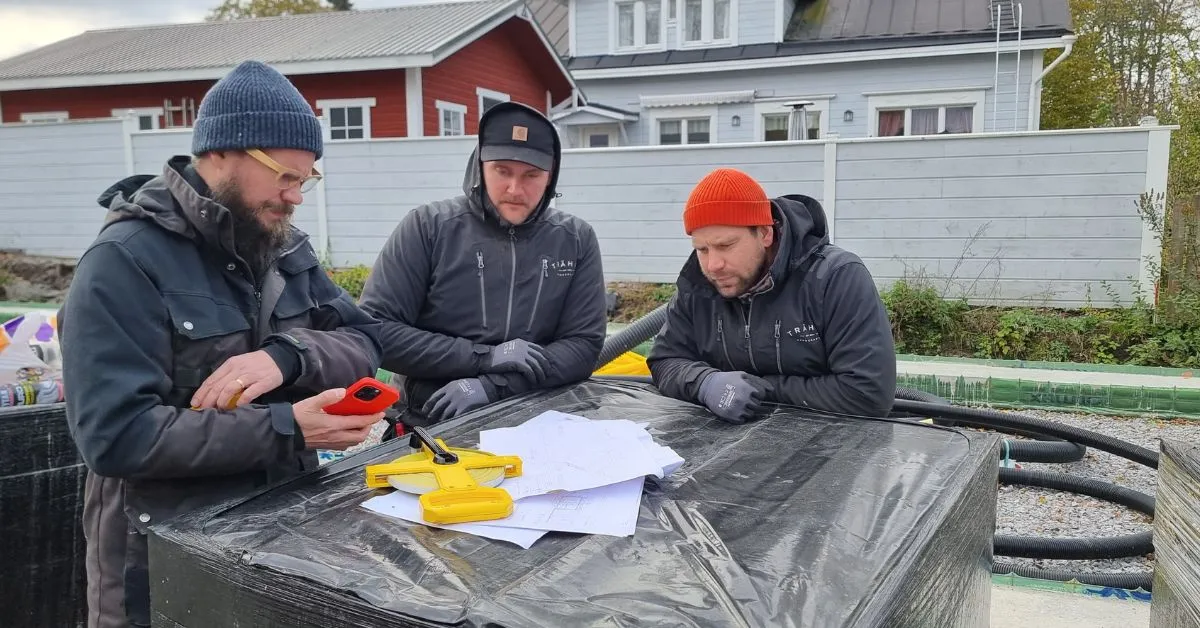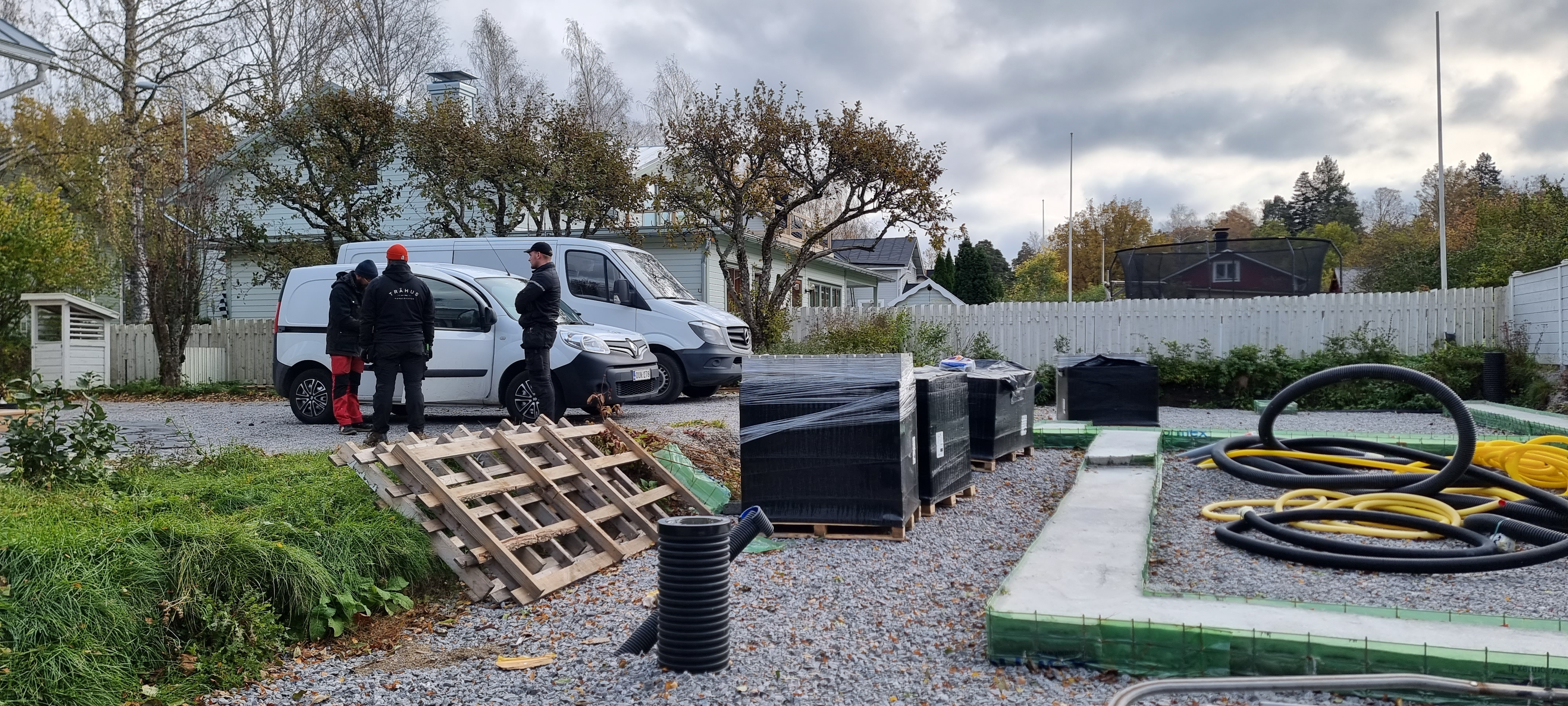At its core, construction field management refers to the coordination of management of the on-site activity. Sounds simple enough. Of course, any field manager or field service contractor knows this can be one of the hardest jobs on a project, as well as one of the most vital.

Whether you’re trying to build a small house extension, a house from scratch, or a commercial building, being able to effectively coordinate and manage work on-site means managing a whole lot of different tasks, from safety to resource management.
From directing resources by getting materials to the site when they're needed, to keeping the client updated with project progress through real-time photos, ensuring site safety by providing protective gear, and much more.
That’s not to mention one of the most important parts of the job, which is looking after all the on-site field staff - a task that only gets more challenging the more staff there are.
But there are ways to make it easier.
It’s one of the reasons we developed Buildbite, after all.
From awesome apps that can help you optimize your time to simple solutions that improve your field management efficiency, it’s time to take you through exactly what field management is, and the 5 best steps to improve your on-site construction project management.
Key takeaway
The 5 core steps to improving your construction field management:
(1) Create a clear communication and collaboration line with your team, and client (two-way communication)(2) Establish performance goals and accountability
(2.1) Cultivate transparency
(3) Invest in employee training
(4) Use proper risk management
(4.1) Utilize a risk assessment matrix
(4.2) Practical risk management guide
(5) Using a field management tool or app
What is field management in construction?
Generally speaking, construction field management is a pretty broad term. It encompasses the full oversight and coordination of all on-site activities during construction projects of any size.
We know. That’s a lot.
A lot of things to plan, manage, and deliver. The core, most important part of field management involves organizing, directing, and supervising tasks to ensure that the project progresses efficiently, stays on schedule, and meets quality standards.
Within this, construction field managers are responsible for coordinating various teams, managing resources, addressing challenges, and ensuring effective communication between different stakeholders, such as broader project managers, contractors, subcontractors, and clients.
The goal of construction field management is to optimize project efficiency, being the guiding hand on-site to ensure everything runs smoothly and as planned while being ready to fix any problems or challenges that may arise.
Field management vs. Field service management
The difference is in the name, with field management involving current on-site construction, and field service management encompassing the management of off-site operations in other non-construction companies.
For example, field management would involve overseeing the building of a new house or block of flats, while field service management would involve managing HVAC technicians sent to a residence to repair faulty air conditioning units.
Field management vs. Project management
Very similar, but not necessarily the same.
While field management as discussed is the coordination of on-site activities, project management operates at a strategic level with a focus on the overarching planning, budgeting, and coordination of an entire construction project, including the preconstruction phase.
It involves tasks such as creating project plans, managing timelines, and ensuring client satisfaction.
This means that a field manager may be responsible for one element of budget management such as dealing with suppliers and resources, but it is the project manager who organizes and manages the budget for the entire overall project, from resources to employee wages, and anything in between.
This essentially boils down to field managers overseeing tasks like coordinating work on-site, managing resources, and addressing immediate challenges, while project managers budget for the entire project, organize contracts, and provide the broader project framework.
For many smaller or mid-sized construction companies, the field manager and project manager end up being the same person, however, larger businesses tend to keep the roles separate.
Why good field management in construction is important
Like the conductor of an orchestra or the director of a film, your whole on-site project is controlled and organized by your field manager. Someone with great field management skills will keep everything running smoothly and efficiently, saving time, money, and hassle across the project.
Ultimately, there are five main areas where good field management can boost your project:
- Time efficiency:
- Efficient field management optimizes construction timelines. This means things like implementing well-organized work schedules and task prioritization, keeping everyone on track, and significantly reducing how long the project takes.
- Efficient field management optimizes construction timelines. This means things like implementing well-organized work schedules and task prioritization, keeping everyone on track, and significantly reducing how long the project takes.
- Cost savings:
- Effective field management leads directly to financial benefits. By carefully managing resources, preventing delays, and optimizing processes, costs related to overtime and unnecessary expenses are minimized, ultimately saving you money.
- Effective field management leads directly to financial benefits. By carefully managing resources, preventing delays, and optimizing processes, costs related to overtime and unnecessary expenses are minimized, ultimately saving you money.
- Risk mitigation (safety):
- This comes in two parts. The first part is all about safety - construction projects can be dangerous places if not managed properly. Aside from the obvious importance of keeping everyone safe for their own sake, having injured personnel also comes with its own host of issues such as paying out insurance, losing manpower, and slowing down the project. A good field manager will ensure everyone is kept safe on-site by establishing clear safety guidelines and procedures.
- This comes in two parts. The first part is all about safety - construction projects can be dangerous places if not managed properly. Aside from the obvious importance of keeping everyone safe for their own sake, having injured personnel also comes with its own host of issues such as paying out insurance, losing manpower, and slowing down the project. A good field manager will ensure everyone is kept safe on-site by establishing clear safety guidelines and procedures.
- Risk mitigation (Costs and rework):
- The second part is avoiding the risk of rework. Costly, time-consuming, and bad for reputation, good field management will make sure everything is done right the first time. For instance, ensuring accurate and precise construction plans and inspections from the outset can prevent costly revisions and adjustments later in the project.
- The second part is avoiding the risk of rework. Costly, time-consuming, and bad for reputation, good field management will make sure everything is done right the first time. For instance, ensuring accurate and precise construction plans and inspections from the outset can prevent costly revisions and adjustments later in the project.
- Client satisfaction:
- At the end of the project, every element of successful field management builds towards one thing: satisfied clients. Delivering the project on time, staying on budget, and providing high-quality workmanship all directly lead to positive client experiences, fostering trust and potential future collaborations.
Read more on how to ensure good customer satisfaction
What are the greatest challenges of field management?

Whether you’re managing on-site construction for a single house or a residential building, field management faces many difficult challenges. Since you’re in charge of basically everything that goes on on-site in the project, you also face some of the biggest obstacles.
The first step to overcoming these challenges is identifying and understanding them. So, here are some of the greatest challenges you may face in construction field management:
Capturing all change requests and additional work
In general, change requests (rework) are costing the construction industry $177 billion annually in labor costs, and this is for the US alone. A lot of construction professionals have a hard time capturing the additional work that falls under the rework category. Ideally, proactive measures should be taken to avoid the necessity of rework, such as:
- Utilizing a field management solution that establishes an ongoing communication flow between you, your team, and your client.
- Prioritizing quality control: create tasks for frequent quality checks and routine observations. This will allow you to proactively identify any potential change requests.
- Making sure to have robust project planning during the preconstruction phase. Having all stakeholders involved and on the same page before construction will reduce the risk of rework.
However, some rework will likely be out of your control due to unpredictable factors. In that case, capturing the rework by time-tracking the tasks will allow you to bill for additional work.
Managing the team
Communication is the lifeblood of any project, construction or not. Your team should be able to easily communicate with each other and yourself, or any other managers. As soon as you have more than a few people on a project, making sure everyone has all the information they need can be extremely difficult.
It is the job of the field manager to overcome the challenges of slow responses to emails, forgetting to update other team members on progress or any other miscommunication.
This means establishing good communication links across the board, both between different teams onsite such as a flooring team and HVAC team, as well as between each on-site individual and anyone off-site like managers or suppliers. It also means building an open, transparent, and comfortable on-site atmosphere where employees are encouraged to be honest at all times.
Read more on how to optimize your team’s collaboration
Working with the client
Delivering on time isn’t the only thing to think about when it comes to working with clients. While different parts of client relations may be handled by other people, such as the project manager handling the bidding process, it is the job of the field manager to keep the client on board during on-site construction, ensuring clear instructions from the client.
Establishing clear expectations with the client and other stakeholders is one of the biggest challenges. Without this, you risk project scope creep, which can lead to increased workload and potential disputes.
Field managers also need to keep the client in the loop to prevent delays in obtaining necessary approvals for work. By keeping the client in the loop, field managers can make sure everything moves swiftly and project timelines stay on track.
The final element is of course keeping the client happy. Nothing’s worse than a client having no idea how a project is going, which is why a field manager should always keep clients in the loop.
Sharing photos, timeline updates, and having meetings with the client goes a long way towards keeping the client happy, alongside delivering high-quality work on time and budget.
Managing your time and information
Loss of relevant documentation is one of the things that can stifle a project, especially at the end. Incomplete or inaccurate documentation can lead to misunderstandings, disputes, and difficulties in tracking project history for future reference.
Alongside keeping track of documentation, it’s also vital to keep on top of all your tasks across the whole project.
Without effective time-tracking mechanisms, it becomes challenging to assess productivity, allocate resources efficiently, and accurately estimate project timelines.
One way to combat this is through the use of digital tools, however, adopting these across an entire project may be difficult. Resistance to adopting modern digital tools may hinder the efficiency gains offered by technology, impacting communication, documentation, and overall project management processes.
Read more about how to manage your project’s documents
5 steps to improve your Construction Field Management
If you want to perfect your field management skills, here are the top 5 steps to get the most out of your construction project through good field management.
1. Create clear communication lines
If you want your construction field management to go well, you need to establish clear communication. For everyone.
After all, ineffective communication is one of the 5 main reasons construction projects may fail.
To solve this, you must establish transparent communication channels across all teams involved, including between separate on-site teams, and channels between on-site teams and off-site managers, subcontractors, suppliers, and clients.
For example, you should implement regular internal team meetings, utilize project management software for real-time updates, and maintain an open-door policy for team members to express concerns or suggestions.
For your external communication, you should keep to a regular schedule of updating suppliers of your resource needs, subcontractors of when and where you need them to work, and most importantly regularly update the client with progress reports and photographic evidence of ongoing construction.
2. Establish performance goals and accountability
The best way to ensure everyone pulls their weight and remains accountable is to clearly define project objectives and individual roles. When everyone knows exactly where the finish line is, and what they are expected to contribute, it is much easier to motivate a team and keep everyone on track.
This means setting measurable performance goals for teams and individuals. It also means you should foster a culture of accountability through transparent, honest, and reasonable communication and expectations setting with your teams and employees.
You should establish clear milestones for completion of the whole project as well as smaller tasks within the project, and track progress regularly so you can recognize and reward achievements throughout.
Accountability is about keeping people on track with their expectations, but it is also about rewarding success, whether it be through pay bonuses, additional holidays, or other means.
A good balance of both will ensure you have a cohesive and accountable on-site team.
3. Invest in employee training
Your employees are some of your greatest assets, and investing in them wisely can pay off massively.
When you have the right team, full of people eager to learn and improve, employee training is one of the best ways to rapidly increase the skills of your on-site crew without hiring new people.
This means providing workshops, certifications, and resources to keep them updated on the latest industry trends and technologies. For example, offer training sessions on new construction methodologies or safety protocols.
4. Use proper risk management with our practical guide
There are lots of different risks associated with field management in construction, from safety issues to budgeting risks.
You can’t stop every risk from happening, whether it be suppliers failing to deliver resources or dangerous equipment malfunctioning. You can, however, plan and prepare to mitigate every risk that may occur on-site.
While planning for so many different risks may seem a daunting task, we’ve developed a comprehensive guide to construction risk management so you can be sure you’ve covered every area.
By following a clear structured guide, you can reduce risks and prepare effectively for any safety issues that may arise.
5. Use a field management tool
Using the right construction field management software can overhaul your field management capabilities like you wouldn’t believe.
This is because of the versatility of apps such as Buildbite, which can increase your operational efficiency across many different areas at once.
A good field management app will be able to quickly improve on and help with many of the previous steps. Need better communication lines? An app such as Buildbite has built-in team chat channels and the ability to upload progress photos for the client to see.
Need more accountability? Assign team members specific tasks within the app. Whether you need your documentation to be more organized and accessible to the team, or better visualization of your current list of tasks, a good field management app will bring you the tools needed.
And that’s what Buildbite was built for!
To give you the tools you need to enhance your field or project management capabilities, cutting down on the time you spend finding specific documents, keeping track of your project, or informing your team.
Transform your construction business today! Experience the power of Buildbite with our free trial. Sign up now to streamline your operations and exceed customer expectations.
Want to learn even more? Read a CEO’s best tips to ensure project success
What to look for in construction field management software
The right construction field management software can be a massive boost to your business, but there are lots of different apps out there for field managers. How do you know which one to choose?
While the right app for you will depend on your business needs, these are some general features that any good software should be able to offer you:
-
Good task management features:
One of the first things to look for is software that facilitates robust task management. This should include the ability to create specific tasks, assign them to relevant people, and the ability to track these tasks across the construction site. This will help you manage each stage of on-site field management more efficiently, as well as boost accountability among team members
-
Effective time tracking:
You should also choose software that has comprehensive time-tracking features, which will allow you to monitor and analyze the time spent on each task. Every year, 22.7% of construction projects are delivered 250 days late.
If you want to avoid potential delays, spending your time and your team’s time more efficiently is a great way to get things done faster.
A good field management app will provide accurate time-tracking aids alongside your task scheduling, helping you compare time estimates vs actual time, and giving you the data needed for accurate performance evaluation of every task on-site.
-
Clear communication features:
Communication is key. Make sure to prioritize software that provides in-built communication tools such as real-time messaging, push notifications, and collaborative platforms. Creating and sharing visual documentation, such as videos and images, will help you and your team both during and after the construction. You’ll be able to:
- Access real-time project updates to effectively track progress and gain a comprehensive overview of the project's status, through video & image updates.
- In the event of any issues, having access to video or image documentation will help you understand the situation to better address and mitigate challenges.
Clear and efficient communication enhances coordination among team members, reducing the likelihood of errors and delays.
-
Simple integration for non-team members:
Not everyone you work with will be a direct member of your team. Because of this, you must select software that promotes easy client and subcontractor involvement through an app that is easy for everyone to understand and use.
This means simplicity in the ability to share progress updates, track milestones, and interactive reporting features for clients, as well as features that enable subcontractors to easily access the project information they need, join communication channels, and update task statuses as they go.
-
Solid documentation organization:
Looking after all the documentation that comes with a construction project can be very time-consuming.
By choosing software that simplifies these documentation processes you can save time, and enhance project transparency, compliance, and overall organizational efficiency.
This means your app should provide efficient and appropriate storage of documents, easy retrieval of said documents for the right team members, and a way of sharing project documents both within the team and to any external groups such as the client or subcontractors.
-
Easy to use:
Whether you’re a small team or a medium-sized business, it’s vital that whatever software you choose is easy to use. There’s no point in saving time with features, only to spend even more time figuring out how to use those features.
Prioritize user-friendly software that encourages widespread adoption among team members, including clients. This should include things like clear tooltips and guides, an intuitive interface, and good customer support from the developers.
What are the different roles within field management?
The field manager isn’t the only person involved with field management - there are lots of different people who contribute to the on-site aspect of the construction project.
But what are these roles, and specifically how do they interact with and support construction field management?
1. The owner (often the CEO):
Owners, who are often the CEOs, occupy a pivotal role, even if not directly in the field. When it comes to field management, their responsibility is to equip field teams and project managers with essential tools for success.
The overall budget of a project, what can be given as incentives for goal achievement, a general timeline, and in some cases the overall strategic approach are all decided by the CEO/owner.
2. Project managers:
As discussed at the start, field managers and project managers share a lot of responsibilities, though are not always in the same role.
The project manager specifically oversees and coordinates various aspects of the construction project at the more strategic level. This means making sure the right contracts are in place, the overall project budget is balanced properly, and other off-site aspects of project planning are taken care of.
We have created a guide on hiring the perfect construction project manager
3. A general contractor:
The general contractor is vital in coordinating any and all subcontractors on a project, keeping an overview of project timelines, and resolving on-site challenges quickly.
4. Subcontractors:
Not everything you need for a construction project can be found in-house. Because of this, subcontractors are often needed to bring specialized expertise to specific project components that your team might not already have.
This could be anything from HVAC specialists to an outside flooring company, depending on what the project requires.
5. The client
An often underestimated yet crucial responsibility for the overall success of a project is the client's role in ensuring alignment with their vision and requirements. This requires clear and open communication between the client and the general contractor on the field.
The client's active participation in providing feedback and approving the work done by contractors is pivotal for the construction project's success. On the contrary, excluding the client from project involvement increases the risks of change requests, ultimately leading to delays and additional costs.
Better field management with Buildbite

There are lots of steps and skills needed for effective construction field management. This being said, nothing helps enhance so many important areas all at once quite like implementing good field management software and apps into on-site construction.
From enhancing communication with a clear hub for discussions, to better accountability with assigning tasks to team members, and creating better client relations through involving them at every stage with milestone updates and photos of progress, a single app can do a lot for your business.
The Buildbite app has all the features you need to enhance your field management process.
From task-tracking features to in-built communication channels - whether you want more accountability and communication, or better-organized documentation, Buildbite has got you covered.
Take control of your construction projects! Try our construction task management app free for 14 days. Simplify your task execution and enhance efficiency.




.jpg)






